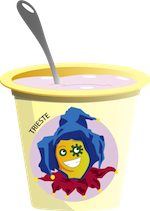Team:Trieste/project/applications
From 2012.igem.org
Application
More
The safe probiotic constructed here can be used to produce nutritious, preventive or therapeutic molecules. For example, this E.coli can express antitumorals, antibodies against different intestinal pathogens, imunomodulators, antigens (recombinant proteins which act as mucosal vaccine) which are important for the correct development of the immune system etc. It can express also different enzymes as lactase or enzymes needed to recreate the metabolic pathways to produce nutrients such as vitamins.

To give a proof-of-concept, we have used our safe probiotic to deliver
to gut mucosa a neutralizing antibody (Ab 54.6)[1] against an emerging
Norovirus (NoV), one of the most common causes of gastroenteritis in the
world. To this end, we used a LPP-OmpA based cell display system[2] to
express the scFv (single chain fragment variable) format of the antibody
attached to the bacterial surface. According to the literature, scFvs
anchored to the bacterial surface can bind multiple viral particles
and protect efficiently against infection. The chosen scFv sequence,
which was already known to inhibit Norovirus (NoV) interaction with
cells, was inserted in frame downstream the LPP-OmpA sequence and
this construct was cloned under a constitutive promoter. LPP-OmpA is a
chimeric sequence having part of the major outer membrane lipoprotein
and an outer membrane porin OmpA fragment. This chimeric sequence acts
as a leader sequence and an anchor, it transports the scFv fused at its
C-terminus through the cytoplasm membrane into the periplasm, where the
scFv assumes the right conformation. OmpA portion then introduces itself
into the outer membrane displaying extracellularly its C terminus with
the Ab attached on.



The anti-NoV antibody was also expressed as a SIP (Small Immuno Protein) format, which contains the scFv fused to the CH3 domain of the heavy chain of human immunoglobulin A (IgA). Since the CH3 region is able to homodimerize, it should confer bivalent binding properties to the anti-NoV scFv54.6. Secreted SIPs have the dual advantage of being bivalent as full-length antibodies and being small as scFvs. They have also been shown to have the potential to protect against enteric infections when administered orally[3]. Eventually, we planned to produce also the secreted versions of the anti-NoV SIP 54.6 and of the scFv 54.6. Both the scFv and the SIP sequences were cloned downstream the pelB leader sequence. PelB drives proteins into the periplasmic space, where it is cleaved off. The resulting proteins can be released into the extracellular space by passing through porins. This system can also be used for production of small, soluble molecules.

References
[1]: Recombinant norovirus-specific scFv inhibit virus-like particle binding to cellular ligands
Khalil Ettayebi adn Michele E. Hardy
Virology Journal, Jan. 2008, 5:21, doi:10.1186/1732-3422X-5-21
[2]: Transport and anchoring of beta-lactamase to the external surface of Escherichia coli
Joseph A. Francisco, Charles F. Eearhart, and George Georgiou
Proceedings of the National Academy of Sciences USA, Biochemistry, April 1992, Vol. 89, pp. 2713-2717
[3]: An antibody derivative expressed from viral vectors passively immunizes pigs against transmissible gastroenteritis virus infection when supplied orally in crude plant extracts
Wendy Monger, Josefa M. Alamillo, Isabel Sola, Yolande Perrin, Marco Bestagno, Oscar R. Burrone, Patricia Sabella, Joan Plana-Duran, Luis Enjuanes, Juan A. Garcia and George P. Lomonossoff
Plant Biotechnology Journal (2006) 4, pp. 623–631 doi: 10.1111/j.1467-7652.2006.00206.x







 "
"









